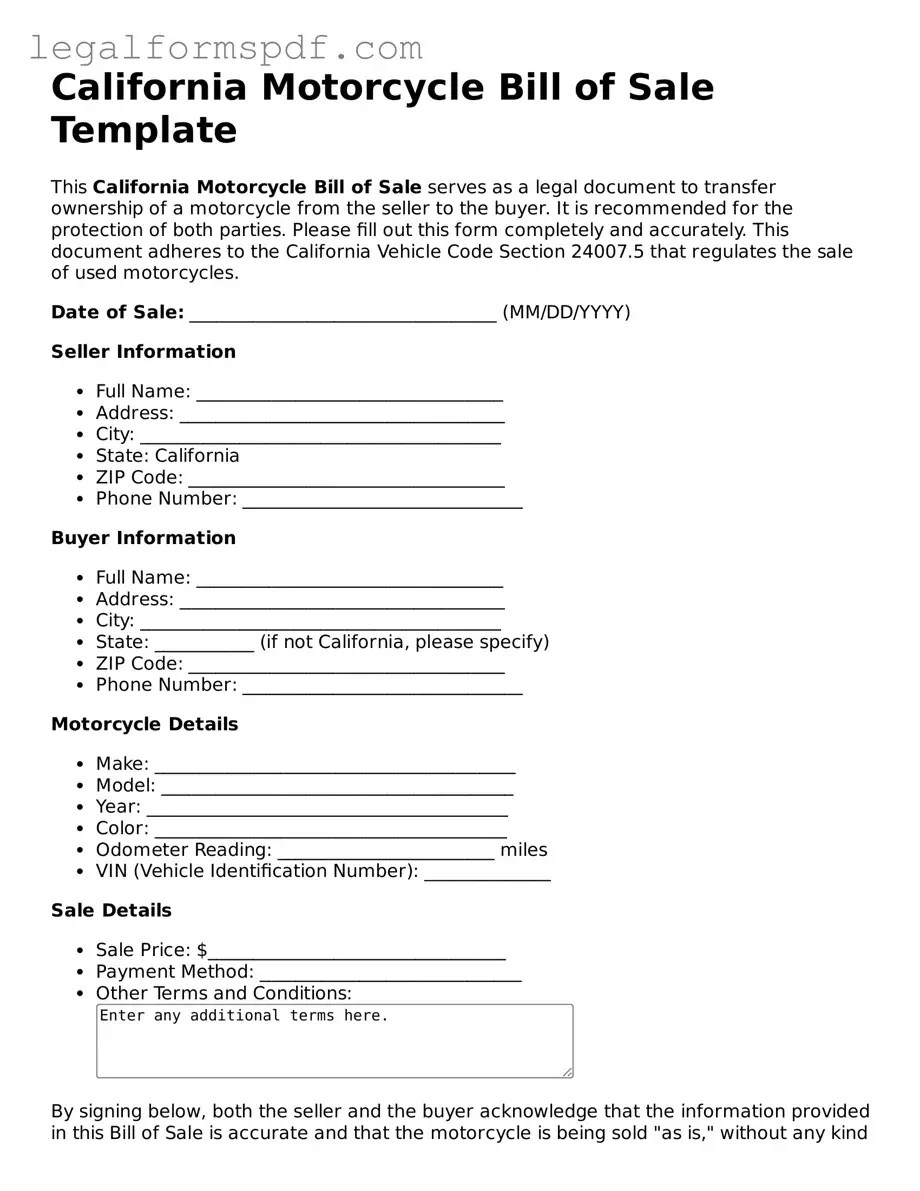The California Motorcycle Bill of Sale form shares similarities with the Vehicle Bill of Sale, used for transactions involving cars, trucks, and other types of vehicles. Both documents serve as proof of sale and transfer of ownership from the seller to the buyer. They typically include details such as the make, model, year, and VIN (Vehicle Identification Number), along with the sale price and the signatures of both parties. This documentation is crucial for the registration and title transfer process in the buyer's name.
Similar to a Boat Bill of Sale, the Motorcycle Bill of Sale is essential for recreational or transportation vehicles that require proof of ownership for registration purposes. The Boat Bill of Sale also captures specific information such as hull ID, length, make, year, and the sale agreement details, mirroring the structure found in motorcycle sales documentation. Both forms are vital for legally documenting the transaction and ensuring compliance with state regulations.
The Trailer Bill of Sale is another document that parallels the Motorcycle Bill of Sale. This form is used when selling or buying trailers and includes information on the make, model, year, and serial number, similar to the details required for motorcycle sales. It's necessary for the legal transfer of ownership and helps protect both parties if any disputes or claims arise after the sale.
Comparable to the Motorcycle Bill of Sale is the Firearm Bill of Sale. Although dealing with very different items, both documents serve to legally document the transfer of ownership, contain detailed information about the item being sold, and include the personal details of both the buyer and seller. These forms often require notarization to add an additional layer of legal validation to the transaction.
General Bill of Sale forms are akin to the Motorcycle Bill of Sale in their function of documenting the sale of personal property from one individual to another. While General Bill of Sale forms can cover a wide range of items, from electronics to furniture, the core purpose of confirming a sale and transferring ownership parallels the specific use case of the Motorcycle Bill of Sale.
The Equipment Bill of Sale closely resembles the Motorcycle Bill of Sale, as it is used for the sale of machinery or equipment, including details about the items' make, model, condition, and serial number. It serves the same purpose of legally documenting sale transactions and facilitating the transfer of ownership, ensuring both buyer and seller have a record of the agreement.
Just like the California Motorcycle Bill of Sale, the Livestock Bill of Sale is necessary for the sale and purchase of animals such as cattle, horses, and other farm animals. It details the transaction, including information on the animal's breed, age, and health status, similar to how the Motorcycle Bill of Sale includes details on the vehicle's condition and specifications.
The Aircraft Bill of Sale is analogous to the Motorcycle Bill of Sale, used when buying or selling planes or helicopters. It includes comprehensive details about the aircraft, such as make, model, serial number, and registration number, mirroring the specificity required in motorcycle transactions. This form is crucial for the legal transfer of ownership and registration with aviation authorities.
The Business Bill of Sale is somewhat similar to the Motorcycle Bill of Sale as it is used in the context of selling or purchasing a business or its assets. While the scope may differ, with the Business Bill of Sale encompassing assets like intellectual property, equipment, and inventory, the fundamental purpose remains the same: to document the sale and transfer ownership legally.
Finally, the Furniture Bill of Sale can be considered akin to the Motorcycle Bill of Sale when it comes to transactions involving personal property. Although furniture sales do not generally require registration with state authorities, the document fulfills a similar role in providing proof of purchase and transfer of ownership, including details such as condition, price, and the parties' consent.
